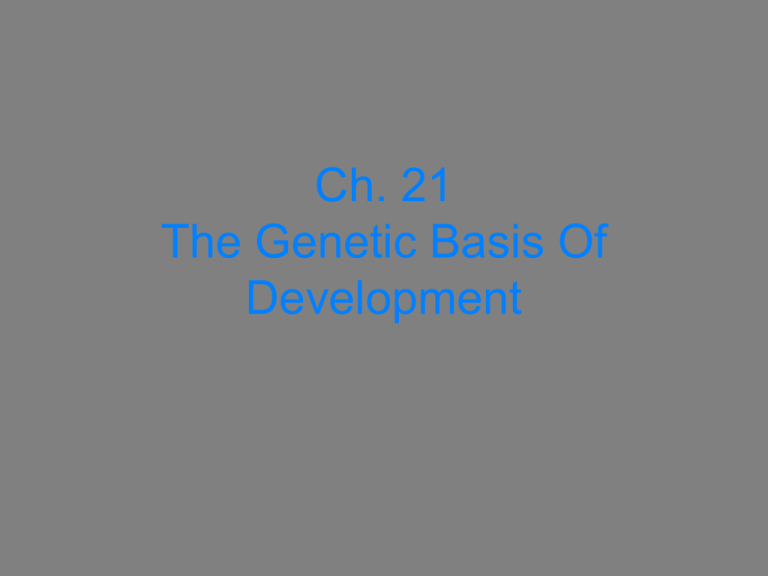PowerPoint Presentation - Ch. 21 The Genetic Basis Of Development
advertisement

Ch. 21 The Genetic Basis Of Development Eye on antennae • I. Embryonic development • A. Three processes make embryo development possible. • Cell division - this would only produce identical cells • Cell differentiation - cells become specialized in structure and function • Morphogenesis - "creation of form" the physical process that gives an organism shape(this is like Power Rangers). • B. All three process overlap • 1. Morphogenesis allows for the basic body plan. Cell division and cell differentiation help to direct morphogenesis. • 2. Animals and plants have different morphogenesis Animals complete morphogenesis during embryonic development, and only grow for a certain juvenile period Plants have areas in which growth occurs throughout the life of the plant called meristems perpetual embryonic regions. These occur at the tips of shoots and roots. • • C. Model organisms used to study development 1. Frogs – They have large eggs that are easy to see – Fertilization and development happen outside the body. • • • 2. Drosophila, C.elegans, mouse, zebra fish (Decker has some of these) and for plants Arabidopsis. 3. Drosophila has a 2 week generation time 4.Caenorhabditis elegans can be grown easily in petri dishes and grows from zygote to adult in 3.5 days. Its genome has been sequenced. They are also hermaphrodites • Mus musculus - mouse, there are now transgenic mice and mice who have had genes mutated, however embryo development is difficult to see. • Danio rerio - zebrafish - easy to breed and generation time is longer than other models (2-4 months) but early development is quick with a fish hatching two days after fertilization. • Arabdopsis thaliana - a weed can produce 1000s of progeny in 8-10 weeks. They are easily transformed • Differential gene expression - we know that all cells have the same genes so how do certain genes get turned on and others not? – Carrot cells taken from the root grew into normal carrot plants (a clone). Plant cells are totipotentthey have the potential to become any type of cell. – Animal cells do not behave like this. Many can not even divide in culture at all. • Attempts have been made to remove the nuclei from a frog egg cell and replace it with the nuclei from various stage tadpole cells. This has been marginally successful. • As embryonic development progresses potency of cells in animals changes. – Dolly - The nucleus from an udder cell into a unfertilized egg cell ( the udder cells were stopped at the G1 checkpoint), then the eggs were implanted into surrogates. Her mitochondrial DNA is from the egg donor. – Many clones do not develop normally because of DNA being methylated in the wrong places and disrupting gene expression. • Stem cells- unspecialized, continually reproducing, can differentiate into specialized cells of different types. – Bone marrow- stem cells for different blood cells – Recently discovered brain stem cells – Pluripotent- cells that can become different types of cells. – Embryos have stem cells that can be made immortal. Stem cell, Brain stem cell • Different cell types make different proteins – Specific cells make proteins that will direct their specific roles in the body. – Cytoplasmic determinants from the mother direct the embryo development – 3. Induction - signal molecules cause changes in developing cells by causing changes in gene expression. Transcription factors Apoptosis Evolution of homologous genes Mice











